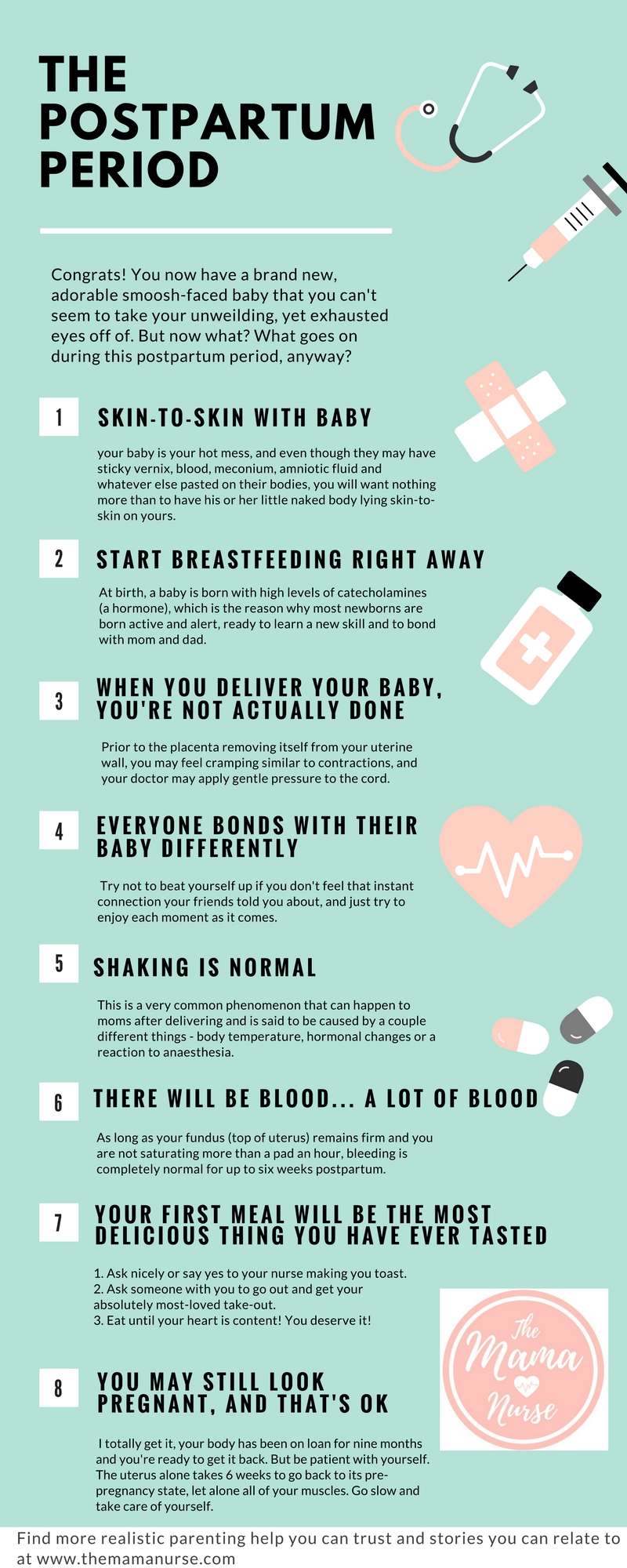Congratulations! Regardless of whether you had an unmedicated birth, an epidural, induction, or water birth, vaginal or caesarean, you all ended up with the same result – a brand new, adorable smoosh-faced baby that you can’t seem to take your unweilding, yet exhausted eyes off of. But now what? What goes on during this postpartum period, anyway?
As if this wasn’t enough, you are now in charge of a tiny being that does not come with instructions, you have to figure out this whole breastfeeding thing when you haven’t seen it done in your whole life because people are prudes, and your delivery room looks like a scene out of Saw.
Well, it’s going to be a tough, yet utterly amazing year for you.
Buckle up.
Lean in.
Be Strong.
You got this, mama.
What to Expect During the Postpartum Period
You Will Probably Have a Hot Mess of a Baby Thrust Upon You… and You Will Love it
As any mother knows already, having a baby is nothing like what you see in the movies. Many newborn babies are, well, a bit of a hot mess. But your baby is your hot mess, and even though they may have sticky vernix, blood, meconium, amniotic fluid and whatever else pasted on their bodies, you may want nothing more than to have his or her little naked body lying skin-to-skin on yours.
Lying skin-to-skin with your baby during the postpartum period feels so right, and for good reason. There is a long list of benefits of immediate skin-to-skin, including:
- Less crying for baby
- Baby’s temperature is more stable
- The Baby’s heart rate and breathing are more stable
- Reduces risk of baby having low blood sugars
- Baby becomes colonized with the same bacteria as mom
- Breastfeeding is initiated sooner
If you are having a c-section, it doesn’t mean that your baby has to miss out. Dad can lie with baby skin-to-skin while you recover, and when you get the go-ahead after surgery, you can immediately start skin-to-skin and breastfeeding your baby!
Babies are Super Alert Right After Birth, and it’s the Perfect Time to Get a Head Start on Breastfeeding
If you are choosing to breastfeed, you will want to start as soon as possible as achieving a good feed in the first few hours after birth will help babies through the sleepy stage they sometimes later go through. At birth, a baby is born with high levels of catecholamines (a hormone), which is the reason why most newborns are born active and alert, ready to learn a new skill and to bond with mom and dad.
When You Deliver Your Baby, You’re Not Actually Done.
It may come to a surprise to many pregnant women, but the truth is that a baby is not the only thing you must deliver – the afterbirth (placenta) must be delivered too. Prior to the placenta removing itself from your uterine wall, you may feel cramping similar to contractions, and your doctor may apply gentle pressure to the cord.
And then you’re still not done! Your perineum (outside of your vagina) will need to be checked for tears and stitches may need to be provided. During these procedures it is completely safe for you to continue skin-to-skin or nurse your baby, so please do!
Everyone Bonds With their Baby Differently
There is some unwritten, inaccurate rule out there that every mother should experience an instant connection with their infants because she carried them for nine months. But life is not always perfect and sometimes your bond is one that is meant to grow over time.
So try not to beat yourself up if you don’t feel that instant connection your friends told you about, and just try to enjoy each moment as it comes.
You can read my article about this on Scary Mommy here.
The Shaking is Normal
After your baby was born, did you have a period where you were shaking uncontrollably even though you didn’t feel cold?
This is a very common phenomenon that can happen to mom’s after delivering and is said to be caused by a couple different things – body temperature or hormonal changes or a reaction to anaesthesia. They are very harmless (although irritating and can make it difficult to hold or nurse your baby), and will generally subside within the hour.
It’s OK if You Take Time to Choose Your Baby’s Name
Don’t worry too much if you draw a blank at first when you meet your new baby. While some parents have had a name picked out since their 20 week ultrasound, others haven’t decided until they get home from the hospital.
While it does make life easier to complete the registration of live birth prior to leaving the hospital, you do technically have 30 days after birth to register. If you can, try to think of a couple options prior to giving birth as it will making the decision-making process much easier.
There Will Be Blood… a Lot of Blood
If you were in bed when giving birth (which isn’t the only option), you may be shocked at the amount of blood that comes from between your legs when you first try to stand up. But there is no need to be alarmed: Excess blood pools within the vagina immediately after birth, which should settle once you have been up for awhile.
As long as your fundus (top of uterus) remains firm and you are not saturating more than a pad an hour, bleeding is completely normal for up to six weeks postpartum and will slowly transition from red to brown to yellow in colour.
Stock up on the Much-Loved, Super Sexy Mesh Stretchy Underpants
You just won’t know what you have been missing until you try wearing our much-loved, always in style, super sexy mesh underpants! Apply two pads for maximum coverage and voila! You are a sexy beast, bleeding contained… For the most part. Steal (or ask nicely for) a couple pairs to take home with you so you don’t have to worry about staining your actual sexy underpants. These typically can also be hand-washed for multi-purpose use.
Is my level of excitement over mesh underpants a tad over-board?
DEFINITELY NOT.
Your First Meal Will Be the Most Delicious Thing You Have Ever Tasted… Even if it is Just Toast
After delivery you will be tired and euphoric and sore and… hungry!
If you have been sipping gingerale and eating popsicles for what seems like forever, do three things right after birth:
- Ask nicely or say yes to your nurse making you toast (their cray or lazy if they won’t)
- Ask someone with you to go out and get your absolutely most-loved take-out
- Eat until your heart is content!
I hereby formally apologise for all obstetrical facilities for not letting labouring moms eat. If you’re looking for more info on why this happens, check out this article about things we do that infuriate labouring moms and why. It’s good for a laugh anyway!
A Good, Hot Shower Will Do Wonders
If you catch yourself in front of the mirror after your first bloody bathroom trip during the postpartum period, don’t be surprised if you don’t recognise yourself at first. Labour and delivery is exhausting and you will probably look like you just crossed Mount Sinai in record time.
But don’t fret! Being able to rinse off all of that blood, sweat and tears will make you feel like a new woman ready to tackle the world! Or breastfeeding and diaper changes, anyway.
Make sure to pack your body wash and loofa for an extra luxurious wash and have your partner watch the baby. You will deserve it! (check out my other suggestions for packing your hospital bag here)
Depending on Whether You Have a Tear, it May Hurt to Pee, Sit Down in a Chair or to Move Your Bowels.
Sorry to be the bearer of bad news, but your down-under has probably seen a better day. So treat it right! Here are some suggestions:
- Ice packs and anti-inflammatories (ask your doctor) for swelling
- Use a peri-bottle while peeing to avoid burning from tears
- Sitting on pillows or a doughnut will help if you need to sit down instead of lie
- Never avoid having a bowel movement. Doing so will make your body absorb more water from your stools and make them harder to pass
- Take your stool softeners and hemorrhoidal ointment as prescribed
- Tucks wipes can be helpful too!
Don’t Be a Hero – Take the Drugs
Once your delivery high has worn off, don’t be surprised if you feel like you were just hit by a bus. Your body has been through an awful lot, and there are safe medications to take while nursing your baby postpartum. Take them as prescribed, and feel free to ask your doctor or nurse questions if you are concerned about whether they will pass on through your breast milk. We want you to be as comfortable as possible!
Breastfeeding is Hard for Most in the Beginning, but it Does Get Easier
Learning to breastfeed is just like anything else – it takes practice for both mom and baby. If it doesn’t go well in the first few days, don’t get down on yourself but do seek help. Some suggestions include:
- Lactation consultants (including me!)
- Your L&D nurses
- Laleche League
- Public Health
- Your Doctor’s office, for routine baby weight checks
- Jack Newman’s website
Also, check out this article about how to know whether your baby is getting enough breast milk!
Watch Out For Those Sticky, Meconium First Poos
For the first few days after birth, your baby’s stools will basically look and feel like tar and they can be very difficult to clean up. You can prevent a headache in the future by lathering your baby’s bottom in vaseline during each diaper change.
You May Still Look Pregnant, and That’s OK
This is a very common complaint with women in the postpartum period, that they still feel as if they look pregnant. And I totally get it, your body has been on loan for nine months and you’re ready to get it back. But be patient with yourself. The uterus alone takes 6 weeks to go back to its pre-pregnancy state, let alone all of your muscles. Go slow and take care of yourself.
You’re Only in the Hospital for 24-72 Hours Postpartum, so Use it Wisely
Do you know what a Labour & Delivery nurse’s favourite thing is?
Parent’s who ask questions!
Please, don’t be timid when it comes to asking questions about postpartum or infant care, breastfeeding, postpartum depression, pain control, bleeding, etc. Generally speaking we love teaching and asking questions means that you care about your baby. And we obviously love that too.
You’re only with us for a couple days as compared to our parent’s time when they stayed in the hospital for a whole week! Use this time to ask questions, rest, and bond with your baby. Save the visitors for when you get home.
P.S. We will also tell people to leave for you if you’re overwhelmed with visitors. All you gotta do is ask!
If you are in need of some extra breastfeeding or infant sleep support, book a free discovery call with me here.
References
Newman, Jack. (2009). The Importance of Skin-to-Skin Contact. International Breastfeeding Centre. http://www.nbci.ca/index.php?option=com_content&id=82:the-importance-of-skin-to-skin-contact-&Itemid=17
Lothian, Judith. (2005). The Birth of the Breastfeeding Baby and Mother. The Journal of Perinatal Education. 14(1): 42–45. http://www.ncbi.nlm.nih.gov/pmc/articles/PMC1595228/





This is brilliant and I love the infographic!! Oh thst shaking. Mine got even worse after I goy home. I couldn’t stop, just sat there and shook. Weird stuff.
Thanks Julie! It is pretty weird. There has been some research as well on whether it is caused by infant and maternal blood mixing during delivery, but not conclusive. Still a bit of a mystery!
I still remember my first meal after I had my son – the most delicious deli sandwich from one of my favorite restaurants. After not eating anything for over 36 hours, it still ranks as one of the best meals I’ve ever had. ?
Lol!
Wish I had read this before I gave birth – all amazing advice and spot on! I love the part about the first meal post birth – hospital food has never tasted so good!!! 🙂 And ice packs, so many ice packs! You can do this mama’s! <3
Thanks for the kind words Erin! I try to make light of L&D as much as possible. There’s no sense being too serious!
This post is awesome! Though, I am not a mother yet but when I will be, the beautiful advices you gave in post is definitely going to help me. Love you loads!
Hey!!! Mama loved this inforgraphic. please help me with the tool name. i am struggling creating these.
AllThatsmom